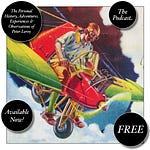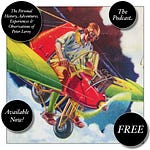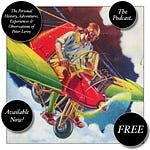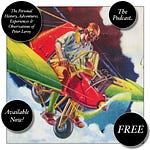Preface
SOMETIMES my memory seems to be mush, with shining moments scattered through it like chips of marble in wet cement or peas stirred into mashed potatoes. I’d like to be able to take a closer look at some of those moments, but whenever I reach for one I disturb the mush, and the moment I seek sometimes sinks out of sight. I reach, I scoop, I grab. Sometimes I get what I’m after, but more often I come up with nothing but mush, or I get hold of a different moment, not the one I wanted. Reaching for a chip of marble, I come up with a pea. Once in a while, though, something—some random turbulence in the mush, perhaps—brings to the top a chip that surprises me, one I haven’t looked for, but one I’m happy to see, like the one that surfaced on a fall morning about two years ago while I was sitting in the sun, reading the Babbington Reporter—the chip that led me to write this book.
Albertine’s parents were visiting, it was a fine morning, and we were all having breakfast on the new deck behind the hotel. Albertine and I have come to enjoy the early days of fall more than any other part of the year. The weather is still fine but there are few guests at the hotel, so there isn’t all that much for us to do—beyond entertaining her parents on their annual visit.
Mr. and Mrs. Gaudet—Martin and Anna—are very fond of me, and I milk their fondness for all it’s worth. That morning, I was lingering over my breakfast, enjoying the sun. Martin padded into the kitchen to fetch me more coffee, Anna spread marmalade on my high-fiber toast, and I turned to “We Pay a Call,” the Reporter’s weekly interview with an interesting Babbingtonian. That week, the Reporter had called on Vivian Stillwell, only daughter of the entertainers Florence Hill and Fred Lucas. Flo and Freddie, as they’d been known professionally, had been enormously popular as radio performers and, later, in the early days of television, ended their career as co-hosts of a daytime show. The interviewer wanted to talk about Vivian’s collection of Flo-and-Freddie memorabilia, but Vivian kept trying to steer him away from what she referred to as “that old junk” and into the cellar, where she had her laboratory, her cold fusion experiments, and her homemade scanning tunneling microscope, or STM. Vivian’s STM allowed her to examine matter on an atomic scale, thanks to a tungsten probe cunningly sharpened to a point just a single atom across. When she applied voltage to this probe, electrons left the tip and, exploiting some quantum-mechanical hocus-pocus, “tunneled” across the narrow gap between the probe and the specimen. While Vivian guided the probe across the specimen in a raster pattern, a system of piezoelectric controls, a feedback generator, and some other clever gadgetry produced images so fine that they allowed her to see individual atoms. All that I found interesting enough, but here’s the part that really got me. “To begin a scan,” said Vivian with undisguised pride, “I’ve got to maneuver the tip of the probe into position only about one nanometer—that’s a billionth of a meter, pal—above the specimen—so close that the electron clouds of the atom at the tip of the probe and of the nearest atom of the specimen overlap.”
When I read those words, my jaw dropped, and I let the Reporter fall into my lap. My eyes drifted out of focus. A feeling of the most pleasant nostalgia spread through me. An extremely vivid pictorial memory lit up my mind’s eye like the final starb urst at the end of the annual Clam Fest fireworks display. A little smile formed on my face.
“Peter!” said Mrs. Gaudet.
“What?” I said, or squeaked, certain that the little smile had betrayed my thoughts, thoughts best kept from Albertine’s mother.
“Your toast,” she said. “It’s getting cold.”
“Oh,” said I, relieved. “That. Well. That’s nothing.”
“Nothing?” she said.
“I mean—thank you. Thank you. I—was just—ah—”
“You’ve been in another world,” she said. “I know.”
“You mean the—uh—the way I kind of drifted off?” I said. “I can explain that—I—”
“Your head’s in the clouds,” said Anna. “I know what you were thinking about, too.”
“Heh-heh-heh,” said I. “Well, Anna, you’re a woman of the world. I’m sure you understand that—”
“The next book,” she said triumphantly.
“I guess you caught me,” I said, relieved that she hadn’t.
“Oh, I know how your mind works,” she claimed. “I’ve known you quite a long time, Peter. I can tell what you’re thinking by the expression on your face.”
I said nothing at all to that, just smiled and ate my toast and drank my coffee, but the truth was that the little smile that had nearly given me away came from the dazzling memory of Miss Rheingold’s legs.
Miss Rheingold’s legs had come to mind because Vivian Stillwell’s description of her atomic-level imaging system had made me say to myself, “Hey, wait a minute! If the electron clouds of an atom in the tip and the closest bit of the specimen overlap, what has happened to the boundary between tip and specimen? How can we say where the tip stops and the specimen starts?”
That thought immediately led to another. It made me think of an old obligation undischarged: the paper I was supposed to write for Miss Rheingold, who taught me general science for part of the seventh grade and had those unforgettable legs. From that beginning I rambled on and on and on through that time of my life. It wasn’t long before I came upon something that made me laugh out loud.
“What’s so funny?” said a voice, but the wrong voice for the memory.
“Huh? What?” I said, looking around. I had expected to hear the voice of my old friend Raskol, as a boy, calling to me from a rickety tower on a hilltop in the middle of a grove of bamboo, but it was Albertine’s father who was asking me the question, smiling at me from across the bistro table where we sat. “Oh,” I said. “I’m sorry, Martin. It’s—um—well, Anna can tell you—it’s just as she said—I’m thinking of the next book—in fact, I’m thinking of the end of the next book.”
This time I was telling the truth. I closed my eyes and resumed my backward ramble until I found myself standing in a locker in the Purlieu Street School, in the heat of an August night. Because I was ten, I fit in a locker, though without much space to spare. If I moved, the coat hook would poke into the back of my neck, but I didn’t move much, because I didn’t want to make any noise. I was where I wasn’t supposed to be, and I couldn’t allow myself to be discovered. I was not afraid, though. I was thrilled. I was playing a game with the watchman. I was thrilled, too, as an adult reliving the moment, because I knew what I couldn’t have known at the time, that while I was there, hiding in that locker, I was gathering impressions that would lead—a year later—to my inventing a game and thereby to my building a permanent memorial, a beacon, marking a single moment of my childhood. This memorial beacon would also be my seventh-grade science project, the final requirement of my general science paper, though at the time when I was standing in the locker the paper hadn’t been assigned yet, and when it was assigned it would take about thirty-five years to finish.
[to be continued]
Have you missed an episode or two or several?
You can begin reading at the beginning or you can catch up by visiting the archive or consulting the index to the Topical Guide.
You can listen to the episodes on the Personal History podcast. Begin at the beginning or scroll through the episodes to find what you’ve missed.
You can listen to “My Mother Takes a Tumble” and “Do Clams Bite?” complete and uninterrupted as audiobooks through YouTube.
You can ensure that you never miss a future issue by getting a free subscription. (You can help support the work by choosing a paid subscription instead.)
At Apple Books you can download free eBooks of Little Follies, Herb ’n’ Lorna, and Reservations Recommended.
You’ll find overviews of the entire work in An Introduction to The Personal History, Adventures, Experiences & Observations of Peter Leroy (a pdf document) and at Encyclopedia.com.












